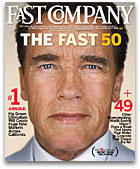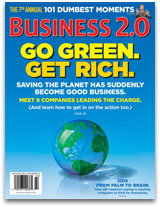If the business press is any indication, sustainability issues have risen up the corporate ladder and are now seen as a central challenge for companies in the coming decades.

In its first-ever green issue, Fortune commends “10 Green Giants” — corporations that are making impressive environmental gains. The editors decided to bypass GE and Wal-Mart, whose eco-endeavors have been heavily publicized, and instead highlight companies whose sustainability efforts have been less high-profile recently — among them, Hewlett-Packard, Continental Airlines, S.C. Johnson, Suncor, and Alcan. While its list focused on big, mainline corporations, its cover went to an idealistic maverick who runs a 350-employee, uber-eco outdoor-gear company — Yvon Chouinard of Patagonia.
Fortune‘s Marc Gunther writes in an intro to the green package that environmentalism in corporate America has gone beyond mere compliance and efficiency: “Now we’re at the threshold of a different era, one in which smart companies are trying to figure out how to profit by solving the world’s big environmental problems.”

Fast Company would seem to agree. Its latest annual “Fast 50” edition — which spotlights trendsetting companies and leaders — features California Gov. Arnold Schwarzenegger (R) on the cover and lauds him for “focusing the power of the free market on major problems” like climate change and dependence on foreign oil. In fact, this year the “Fast 50” is wholly focused on companies aiming to be green or socially responsible, from NativeEnergy to EcoFish to Home Depot, which now boasts that 95 percent of its wood products come from sustainably managed forests. The issue’s lead essay argues that we have to shift to Business 3.0 — a new, socially and environmentally sustainable set of economic and business models that acknowledge “we can’t continue indefinitely to cannibalize our life-support systems for spare parts.”
Even more striking, in a recent BusinessWeek column, Jack and Suzy Welch write of the “global warming wager” — quite a breakthrough when you consider that Welch, former CEO of General Electric, has had a long-standing antipathy to the environmental agenda. While the Welches still aren’t convinced there’s a climate crisis — “we simply don’t know” — they argue that the weight of the evidence suggests do-nothing strategies now would be “bad business.” Business leaders should act as if the risks are real: even if they are less serious than originally feared, “your plants will use less energy and emit fewer effluents. Your packaging will be more biodegradable, and your new products will be able to capture any markets created by severe weather effects.”

Business 2.0 magazine may be a bit wary about buying that “Business 3.0” jargon (for the same reason 20th Century Fox didn’t much look forward to the millennium), but it too is on board with the broader sustainability message. “Go Green. Get Rich,” it declared on a recent cover. The issue pinpointed nine environmental and social problems that will create massive new market opportunities — not just climate change but malnutrition, epidemics, and overfishing. It also quoted Ray Lane, a partner at venture-capital giant Kleiner Perkins Caufield & Byers, to the effect that “clean tech” will be “bigger than the internet, by an order of magnitude.”
Compare that with the picture 20 years ago, in 1987, the year we founded SustainAbility and also the year when the Brundtland Commission published its watershed report Our Common Future. That report spurred the slow, long haul of putting sustainable development on the political and business agendas. For several years, our firm ended up helping the rest of the world learn how to spell sustainability.
These days the S-word is everywhere (and most of the time spelled correctly). We’ve made dramatic progress in the past two decades toward a paradigm shift in business thinking — albeit against the backdrop of accelerating deterioration in such areas as climate change and the collapse of oceanic fisheries. Few are still in denial about the scale of the challenges, though many are unclear about what to do next.
Eye on India
So where will we be 20 years from now? Shell recently convened a bunch of us from around the world to discuss the future of technology and sustainable mobility out to 2027. The location, Bangalore, was fitting, as so much is happening in India that is of global importance in the sustainability debate.
Even a week’s immersion in the country provided a wonderful opportunity to get a sense of what is going on in this giant, rapidly mutating society. We visited NGOs and social entrepreneurs, but also took time to see a number of leading Indian companies, from Infosys, which has emerged as one of Asia’s leading IT companies, to Orb Energy, a Shell Renewables spin-out that focuses on supplying solar photovoltaic systems to rural users. And a meeting with a key figure on the corporate-social-responsibility side of Unilever’s Indian operation highlighted the importance of the water issue; he had just come back from working as a volunteer on a rainwater-harvesting project. If you are seeking clues about where the future will take us, India is a great place to look.

One afternoon, Shell split us into working groups beside a hotel swimming pool, the sun beating down. One of your authors — part of the group discussing the future of scanning, sensing, and surveillance technology — idly suggested that it might help to spy on what a neighboring group was thinking, and mused aloud that a robotic dragonfly would meet the need nicely. We got into an impassioned debate about whether the spying device needed to be robotic or whether it could be an electronically steered real insect — following an earlier presentation on how the Australians are now wiring up cows so they can be virtually fenced in via satellite using electric “stimuli” from collars. Then, just a few moments later, a giant dragonfly appeared, zooming across to hover inquisitively over our group.
Who knows who it was reporting back to? But we wish we had a few of the things to help us keep an eye on developments across this extraordinary subcontinent.
India’s energetic entry into the global economy is creating many shockwaves — positive in terms of job creation and opportunities for the country’s fast-growing population of college graduates, but also negative in terms of exacerbating the country’s already tremendous inequality and the world’s already tremendous environmental burdens. We all have a vested interest in what happens there, as Mahatma Gandhi foresaw decades ago. “God forbid that India should ever take to industrialism after the manner of the West,” he once warned. If the populous nation “took to similar economic exploitation, it would strip the world bare like locusts.”
Instead, we hope that the India 2.0 emerging now — and the 3.0 version to follow — will be a leader in new development pathways, forged by sustainable companies that will deserve to be profiled in future green issues of Fortune.



